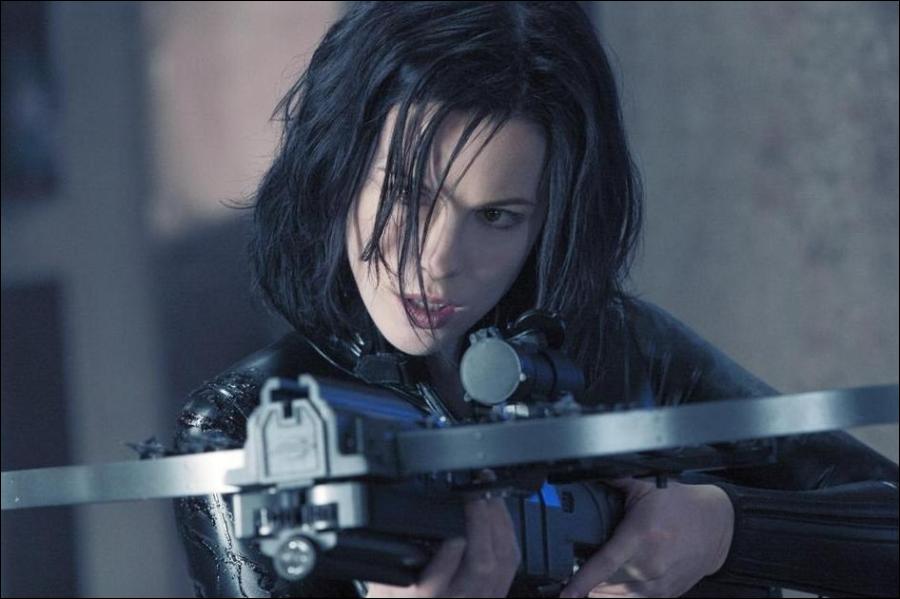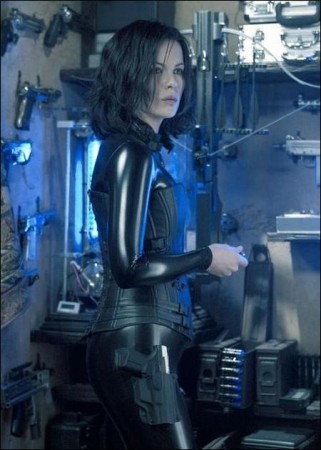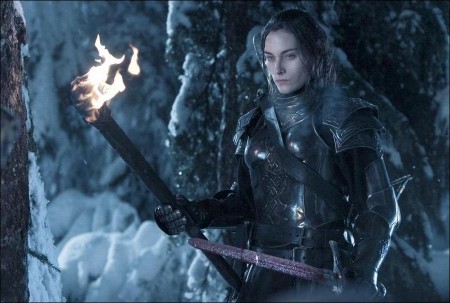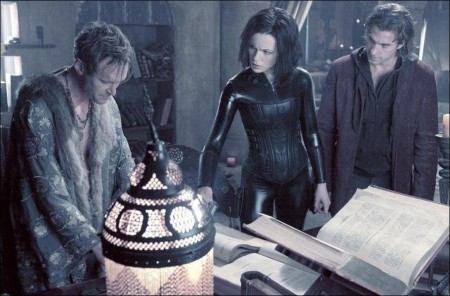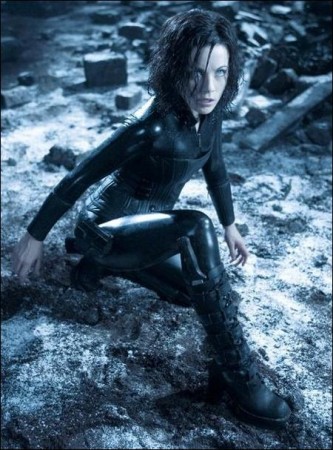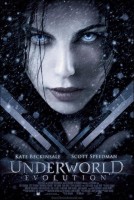The sequel to the $100 million worldwide hit, “Underworld: Evolution” continues the saga of war between the aristocratic Death Dealers and the barbaric Lycans (werewolves). The film traces the beginnings of the ancient feud between the two tribes as Selene (Kate Beckinsale), the beautiful vampire heroine, and Michael (Scott Speedman), the lycan hybrid, try to unlock the secrets of their bloodlines. The fast-paced, modern-day tale of deadly action, ruthless intrigue and forbidden love takes them into the battle to end all wars as the immortals must finally face their retribution.
For centuries, two races have evolved hidden deeply within human culture ‘ the aristocratic, sophisticated Vampires, and the brutal, feral Lycans (werewolves). To humanity, their existence is no more than a whisper of a myth. But to each other, they are lifelong mortal rivals, sworn to wage a secret war until only one race is left standing.
In the midst of this ongoing struggle, a Vampire warrior, Selene (Kate Beckinsale), discovers a Lycan plot to kidnap a young human doctor. After shadowing Michael (Scott Speedman) through the city, she forms an unprecedented bond with him, and when the Lycans make their next move, Selene is there to fend off their vicious assault.
As the feud between vampires and werewolves escalates to new heights, so too does Underworld Evolution, delivering a veritable feast of bloodthirsty power, forbidden love and sweeping vengeance. With the exposure of well-kept secrets and the tough resolve of one betrayed Vampire warrior, a centuries-long struggle between vicious predators has reached new heights of fierceness.
But it’s one Immortal’s insatiable lust for power that leads to disturbing new disclosures about the origins of the feud between the Vampires and the Lycans. The past just got very twisted, and the future may reveal an entirely new breed, the likes of which no one has ever seen.
The Underworld saga continues as hunted Vampire Selene (Kate Beckinsale) seeks out Marcus (Tony Curran), king of the Vampires, in the hope of bargaining for her life. Hybrid Michael (Scott Speedman) wants to join Selene in her quest but is unable to trust the werewolf raging uncontrolled inside him, and she refuses his companionship. Their love proves more powerful than genetics, however, when Marcus descends upon Selene, intent on annihilating her. In the battle that ensues, Selene discovers that she has been betrayed by her own family and she sets out to seek her revenge.
Selene seeks out Adrian Tanis (Steven Mackintosh), official Historian of the Covens, for help unraveling the web of lies spun by Marcus and Viktor (Bill Nighy) in their battle for supremacy. Intrigue deepens when Tanis reveals the identity of the first true Immortal: not Marcus or Viktor as was believed, but Alexander Corvinus (Derek Jacobi), father to Marcus and his twin brother, William. Corvinus, like an omnipresent god on the fringes, has been tracking everyone’s movements and cleaning up after their wars, intent on keeping his descendents confined to the shadows of human society.
Side by side, Selene and Michael battle the horrifically strong and determined Marcus, who is determined to release his imprisoned brother William from captivity and use his bloodlust to achieve world domination. Each confrontation unearths new revelations, casting a harsh light on previous events and cutting through the darkness of painful memories buried deep within.
Kate Beckinsale (The Aviator, Van Helsing) and Scott Speedman (The 24th Day, My Life Without Me) reprise their roles in this exhilarating sequel, which sends the Underworld legend to the next terrifying stage, unleashing, new action, new secrets and an entirely new breed that is more powerful than any of them.
The Evolution of a Story
“You want to know what I know? I know about war.”
As Underworld Evolution begins, Selene is trying to come to terms with what’s troubling her. The memory of her family’s massacre has always haunted her, but now that she knows it was Viktor who murdered them, Selene’s world is in tatters. How many Lycans have died at her hands because she believed they were responsible? How many more would she have slain if Kraven had not revealed this shameful secret? And how many more lives will be lost before the past can be righted?
“The beginning of the movie is a very shaky place for Selene,” says Kate Beckinsale, who reprises her character for the sequel. “Everything she thought for hundreds of years to be true, is not. She’s killed a lot of werewolves in a revenge that was completely misplaced. And now, having killed Viktor and alienated herself completely from the vampires, her only ally is Michael, who himself is struggling with the fact that he’s just become a hybrid.”
Selene’s only hope is to enlighten final elder Marcus upon his awakening. Once he, too, knows of Viktor and Kraven’s surreptitiousness, surely he will forgive her for slaying an elder, yes? But what Selene — or anyone else, for that matter — hasn’t bargained for is that Marcus has also become a hybrid, thanks to the blood of the Lycan Singe spilled by Viktor. Now, with Amelia and Viktor both dead, there is no one strong enough to challenge this powerful, new breed. Or so Marcus thinks.
“Marcus has become extremely powerful and he’s definitely got ideas above his station now,” explains Tony Curran, who brings the megalomaniac hybrid to life. “He sees himself as this godlike figure. There’s a moment where he says, ‘A true god has no father.’ He’s got this wild plan in his head to free his brother, William, the first and most dangerous werewolf, and take over the world with him. Marcus is a serious threat because the only other hybrid that exists on the planet is Michael. No other vampire, human, or Lycan can stand up to him. They wouldn’t stand a chance.”
Kraven is the first to learn this, when he tries to kill Marcus before the full awakening, only to become a victim instead. As he takes his final breath, Kraven’s memories course through Marcus, revealing the location of a pendant that once hung from the neck of Lucian. Now Michael has the pendant and Selene, unknowingly, is the key to its use.
Selene and Michael become aware of the new terror in their midst when Marcus descends on Michael, intent on killing him and claiming the pendant for himself. In doing so Marcus reveals its value, but its significance remains a mystery. What Marcus knows that Selene does not is that she “is the last piece of the puzzle,” explains Curran. “The strong house was built by her father; Viktor killed her family to keep the secret safe, so William would never be released.” With Viktor’s death, Selene alone now holds the knowledge of William’s whereabouts.
Selene and Michael survive the first battle with Marcus, but with dawn fast approaching, there’s little time to ferret out the pendant’s meaning. Michael takes control, finding cover for Selene and finally taking his rightful place alongside her. No longer a casualty in need of Selene’s heroics, Michael is coming to terms with his own power, with the role fate has thrust upon him, and with his feelings for Selene. “They’re falling in love and he’s there for her. He’s her support,” says Scott Speedman who returns to the role of Michael. “He’s still figuring out what he is, but he’s no longer a victim. Instead of just watching and reacting, a pedestrian to all the action, his is now a much more dynamic character.”
The escalation in Selene and Michael’s relationship answers the question often asked after the success of Underworld. “I intended for the first film to end with the relationship beginning,” admits director Len Wiseman.
“There was this Romeo and Juliet aspect in the story of Lucian and his vampire love, Sonja, and then with Michael and Selene. Selene hates humans, so that relationship was not really given a chance until the film was closing. So at the end people speculated, ‘Will there be a relationship? What will that relationship be like? Will it build?’”
Beckinsale had a close-up view in the development of her character for the new film, and a special chance at providing input. “In terms of story and the mapping of my character, I was very much consulted,” recalls Beckinsale. Both she and Wiseman wanted more extensive character development of Selene, something they felt was missing in the first film.
“Selene was more enigmatic than we had hoped,” explains Beckinsale, “and whilst that was all very cool and action heroine-ish, we really relished the opportunity this time to show a few more sides of her. She’s really fighting her fight this time. She’s much more clear about why she’s fighting, a lot more passionate. And she and Michael definitely share a vulnerability between them, too.”
Adds Wiseman, “She’s starting to get a little bit more in touch with her human side. She’s gotten out of this cold robot killer mode, and that was very exciting, to see different sides to her.
Under the cover of night, Selene and Michael seek out Adrian Tanis, Historian of the Covens, who can explain the pendant’s enigmatic past. Banished for allegedly spreading malicious rumors, Tanis passes his exile engaging in either orgiastic bloodletting or arms brokering with the Lycans. His double-dealing exposed, Tanis quickly discovers he has little bargaining power when Selene demands answers. “They’re interested in information and I’m interested in surviving,” shrugs Steven Mackintosh, who plays Tanis. “So it’s a deal. Selene’s quite formidable so I have to spill the beans: the pendant is the key to Marcus’s twin brother’s cell, the location of which is locked away in Selene’s memories, and the first Immortal was not Viktor as always declared but the father of Marcus, Alexander Corvinus.”
Bringing a classy regality to the role of Corvinus is a legitimately legendary acting patriarch, celebrated British actor Sir Derek Jacobi. “Yes, it’s true,” admits Jacobi, “I’m afraid I am the daddy of them all. I’m responsible for the whole thing.” A twelfth-century nobleman, Corvinus had survived a devastating plague which mutated his genes, creating the first Immortal. He later had three sons: Marcus, bitten by bat; William, bitten by wolf; and one who walked the lonely path of mortality. (Michael, as a descendant of this last son, remained a pure-blood until a Lycan bite changed his destiny. His mortal-plus genetic makeup, however, prevented him from death, so when Selene later bit him after a violent battle with Viktor, Michael’s fate was sealed: the world’s first hybrid was born.)
Twisting the myth into something more scientific was a conscious decision of Wiseman’s. “I’m not a huge fan of the older films and legends,” the director explains. “I’m not into the religious vampires where you hold up a cross and they cower. I see that as ‘fantasy’ vampires, while in my world there’s ‘reality’ vampires; it’s more based in science. It’s about a rare blood disease, a plague, rather than anything too fantastic. I wanted to see something different, so I approached Underworld as a straightforward action film that happens to have these horror characters in it.”
It’s a view that allowed for more complex emotions. It meant someone like Corvinus, faced with a curse he unleashed upon the world, would be incapable of killing his two monster sons and destroying the lines before they had the chance to evolve. Instead, explains Jacobi, he elected “to contain the war, to clean up the mess, and to try and hide the history of his family.”
It also means that Viktor, who is played by Bill Nighy in a flashback sequence that begins the new film, was merely a usurper. “I was the first,” declares Tony Curran of Marcus, “but it doesn’t mean I was the most powerful. I was an arrogant young vampire; Viktor was a powerful man and when he became a vampire, being older and more experienced, he took over the leadership.” Viktor then used his power to wage war on the werewolves who at the time were far more destructive and uncontrollable than their later progeny.
But why wouldn’t Viktor just kill Marcus and William? Viktor believed the myth that if the two brothers were destroyed all their descendents would die as well. So he kept the war alive and, to ensure his own power, prevented a merging of the lines even at the cost of his own daughter’s life. And it didn’t hurt that Corvinus was prepared to clean up after the despot vampire.
Corvinus thus became as much a prisoner as his werewolf son, condemned to roam the globe in an enormous stealth ship from which he observes all earthly activity and, when necessary, sends out his army of “Cleaners” to erase any evidence of a preternatural world. “The ship is ‘NASA’ control really,” says Derek Jacobi. “It’s the hub of everything from where Alexander can keep an eye on things and contain what is happening so things don’t ever get too far out of hand.” But Corvinus’ efforts are doomed to failure. “Things are going wrong and Alexander’s powers are in jeopardy.
Intent on finding Selene and the keys to his brother’s cell, Marcus seeks out Tanis for information but is far less generous and forgiving than Selene. Marcus sucks Tanis dry of his memories before ending him for good, then heads out after Selene, the key, and his own father.
When Selene and Michael arrive at Corvinus’ ship, Marcus is hot on their heels. Marcus takes out Michael first, impaling him on the dock the ship is tethered to. Believing the wound fatal, Selene explodes in tears of loss and fury, but in the ensuing fight with Marcus her wounds feed him memories, including the location of William’s prison.
His confidence and arrogance on a dangerous rise, Marcus confronts his father. When the son’s monstrous presence is summarily rejected, Marcus tears his father to shreds and leaves him for dead. The calculation proves shortsighted, however: a seriously wounded Corvinus bequeaths his powers to Selene in the hope of stemming the tide of blood.
Then, in what appears to be his final act, Corvinus destroys his ship. But, as Derek Jacobi slyly points out, “Although you see me fade away with an ecstatic look on my face, where exactly I’ve gone is a bit of a mystery.”
Meanwhile, Marcus, key in hand, has found his brother’s cell. Marcus places the key in the intricate medieval lock, and hell on earth is released. But Corvinus’ Cleaners and Selene are close behind. An apocalyptic battle ensues and, true to its promise, a son arises from the ashes: Michael!
Our heroes have little time for a reunion, though: William and Marcus are still hell-bent on victory. A final confrontation leaves William dead from Michael’s fangs, and Marcus reduced to a tornado of flesh and blood. Daylight nears. But to our vanquishers’ amazement, the rays of light that emerge are no longer harmful to Selene. “600 summers. 600 falls. And finally, again… the sun.
The Evolution of a Look
When Underworld became a sleeper hit of 2004, with worldwide earnings five times its budget even before the heat generated by the DVD release, Lakeshore Entertainment immediately began pressing for a sequel. The success of the film surprised everyone, especially director Len Wiseman, who was suddenly confronted with an audience hungry for new developments. It was a “weird experience,” Wiseman admits, this “pressure to satisfy the fans,” yet the act of revisiting established characters and themes, and working with many of the same cast and crew from Underworld, was a comforting idea. “The process of going back and stepping back into it,” he says, “was a bit like going back to high school or summer camp: you’re back with friends.”
Producer David Coatsworth adds, “With a sequel there are such expectations that you’re obliged to make it bigger and better, so that was very much part of the mandate.” The budget this time around was larger, he says, but “not Hollywood blockbuster enormous. The biggest challenge was more on the creative side, getting the right look, getting the right action and figuring out the cleverest way to execute it within our means.”
The first decision was to go in a new visual and textural direction from the blue-ish subterranean monochrome of the previous film. “This film has a bit more color but in different environments,” says Wiseman. “Underworld was also very urban and kind of claustrophobic while this film opens up. It’s on the run. It’s outdoors. It’s in the mountains. I didn’t want to do the same film over again.”
The second decision was to shoot the film in Vancouver, Canada, instead of Budapest, where Underworld filmed. The new film’s setting was more distinctly rural than city-confined. Much of Underworld Evolution unfolds in high altitude mountain forests and coastal regions, which was fitting for Vancouver, a port city nestled by rainforest coastal mountains only a short flight from L.A., and known for its world-class crews.
It wasn’t a perfect situation, however: the lack of European architecture meant erecting sets from scratch. But, as production designer Patrick Tatopoulos points out, limitations can fuel creativity. When the script required an ancient monastery, something decidedly lacking in modern Vancouver, Tatopoulos built one into the mountainside: “For the exterior I designed a cross that’s stuck into the rock face, and the whole monastery is inside the rock,” says Tatopoulos. “Sometimes because you don’t have the cash you have to think of something different, and often it’s actually better. The monastery came out looking pretty cool.”
Tatopoulos, who had designed the creatures for Underworld, took on production design duties this time around, a job which grew organically out of his working relationship with Wiseman, whose background is in production design, props and visual effects. “Len and I are very much in sync together,” says Tatopoulos.
“Besides, the true judge of a designer is not to come on with his own vision. You’re here to bring out the vision of the director. And Len is definitely one of those guys that is very influential in the look of the movie, probably because he comes from our department. So Len did some rough sketches and once we saw we were in sync he loosened up a bit. Everything came following that same language and it was more relaxed.”
Wiseman’s visual acuity is something producer Coatsworth recalls with satisfaction: “Early on we were reworking some of the scenes and the writer asked Len if he’d gone over the new pages and if he were happy with the changes. And Len replied, ‘I don’t know. I haven’t drawn them yet.’ It was a very telling insight into how his mind works, in that he can see words on the page but he really expresses himself through drawings. He illustrated many of the scenes himself and gave the rough boards to the illustrators. The words are just a starting point for him.
“This guy is a world builder,” adds producer Gary Lucchesi. “He’s extremely talented. And he knows what he’s doing. There are very few directors that really understand how to combine live action with visual effects, who really understand both mediums perfectly. Len knows all of that stuff; it’s in his soul.”
Wiseman’s design origins led to the director often eschewing extensive CGI to answer creative challenges, and instead leaning toward in-camera techniques like stunt work or model building. “Len is a big fan of practical,” explains Tatopoulos. “Practical takes more time; it’s a lot more effort from the director. It’s more painful in some ways. CGI is often easier, but it’s very important that you stick to practical as much as possible.
It’s more believable. Even if an aspect of a scene is turned into a CGI, we need to make sure we always have something real on camera. Let’s say the wings of the bat might be CGI but the character is in makeup; you have something palpable to believe in. So you pay less attention to the CGI. If there’s a real understanding of what helps the other and you have great teamwork, then you can achieve something that looks better than either technique alone.”
This theme of a singular vision but collaborative effort extended to Wiseman’s relationship with his cast as well. “He’s wonderful,” enthuses Sir Derek Jacobi. “He’s got a fantastic eye. He knows exactly what he wants. He’s very detailed, very meticulous. He’s highly complex but his attitude to the actors is very straight. He’s not one of those dictatorial directors who’s hung up on his own neurosis. Len’s one of the gang, the leader of the pack.”
Scott Speedman concurs wholeheartedly. “It’s been pretty amazing to watch him come into his own on this movie,” he says. “I really think he’s going to do special things. He’s extremely talented. He’s more than generous and just very easy. And he’s not a sycophant. He doesn’t just kiss your ass and tell you it’s great.”
Behind the camera, Wiseman had expert help from lauded cinematographer Simon Duggan, fresh off I, Robot. What Duggan found most interesting, and liberating, about shooting Underworld Evolution was the near total absence of daylight shooting. “As it’s a movie about vampires and werewolves, the whole lighting and location scenario is all set at night or pre-dawn, so there are no sunlight hours to think about. That gives you quite a huge scope to do what you want with the light, to make the locations look as beautiful as you like.”
The addition of rural locations to the story also added to “the visual feast,” though one key locale came with unexpected problems. The medieval village scene opening the film required abundant snow, something normally not a problem in Vancouver’s high mountains, but the area was experiencing an unusually dry winter and, as the day drew near, snow was scarce.
But fate smiled upon the production. “When you create a winter scene, fake snow is one of the most expensive elements,” says producer David Coatsworth. “All during the construction of the village there was virtually no snow, but about three days before we shot it began to snow and snowed for about 72 hours nonstop, so we had more snow than we could ever have hoped for. And then about 24 hours after we finished, the Pineapple Express rolled in from Hawaii and melted every bit of snow on the mountain. So we hit this perfect window of about ten days and got everything we needed. There’s so much snow it looks like it was dressed on a back lot. It worked out brilliantly.”
Duggan was equally pleased with the results. “It was just fantastic, this medieval battle scene in the snow with horses and werewolves and black armor. It was incredible visually with the snow falling at night and lots of blood and fires burning. It’s quite a beautiful scene.”
These production notes provided by Sony ScreenGems.
Underworld: Evolution
Starring: Kate Beckinsale, Bill Nighy, Tony Curran, Scott Speedman, Derek Jacobi
Directed by: Len Wiseman
Screenplay by: Danny McBride, Len Wiseman
Release Date: January 20, 2006
MPAA Rating: R for strong bloody violence, sexuality and nudity.
Studio: Sony ScreenGems
Box Office Totals
Domestic: $62,318,875 (56.0%)
Foreign: $49,021,926 (44.0%)
Total: $111,340,801 (Worldwide)
